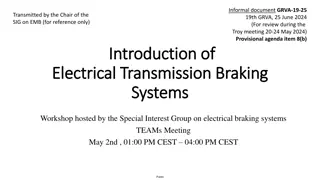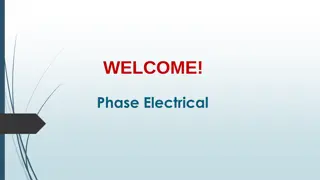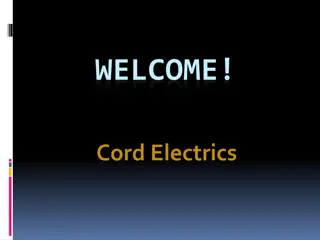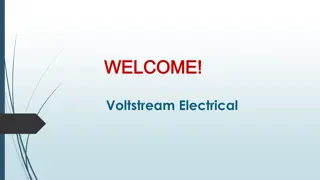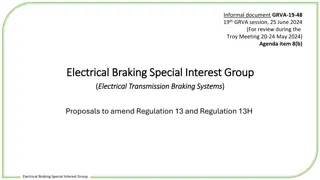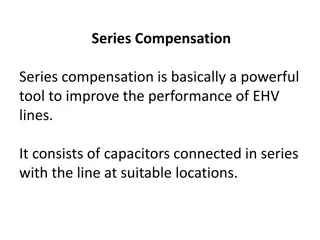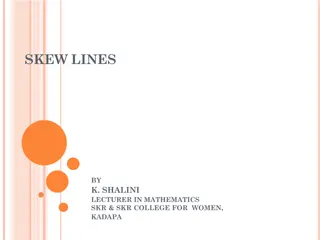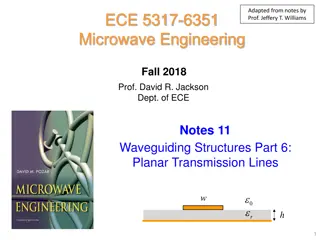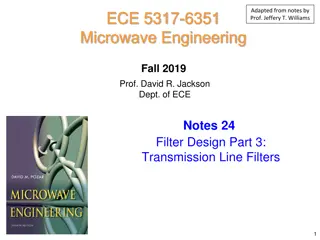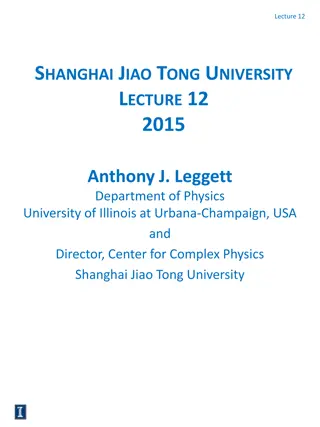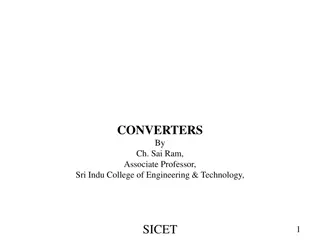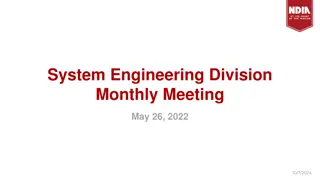Understanding Performance of Transmission Lines in Electrical Engineering
The performance of a transmission line in power systems is critical for efficient operation. Factors such as voltage drop, line losses, and transmission efficiency are key considerations in design and operation. The line parameters of resistance, inductance, capacitance, and shunt conductance play crucial roles in determining the line's performance. Inductance, capacitance, and shunt conductance affect the efficiency, voltage regulation, power factor, and stability of the transmission system. The classification of overhead transmission lines based on length and voltage helps in analyzing their performance characteristics. Important terms like voltage regulation and transmission efficiency are essential for evaluating the effectiveness of a transmission line.
Download Presentation

Please find below an Image/Link to download the presentation.
The content on the website is provided AS IS for your information and personal use only. It may not be sold, licensed, or shared on other websites without obtaining consent from the author. Download presentation by click this link. If you encounter any issues during the download, it is possible that the publisher has removed the file from their server.
E N D
Presentation Transcript
BINESWAR BRAHMA ENGINEERING COLLEGE DEPARTMENT OF ELECTRICAL ENGINEERING POWER SYSTEM-I Performance of Transmission line BISWANATH HAJOARY Asst. Professor Department of electrical Engineering 1
Performance of transmission line The important considerations in the design and operation of a transmission line are- the determination of voltage drop Line losses efficiency of transmission The performance of transmission line depends on the parameters of the line. The transmission line has mainly four parameters, resistance, inductance, capacitance and shunt conductance. These parameters are uniformly distributed along the line. Hence, it is also called the distributed parameter of the transmission line. The inductance and resistance form series impedance whereas the capacitance and conductance form the shunt admittance. 2
Line inductance The current flow in the transmission line induces the magnetic flux. When the current in the transmission line changes, the magnetic flux also varies due to which emf induces in the circuit. The magnitude of inducing emf depends on the rate of change of flux. Emf produces in the transmission line resist the flow of current in the conductor, and this parameter is known as the inductance of the line. Line capacitance In the transmission lines, air acts as a dielectric medium. This dielectric medium constitutes the capacitor between the conductors, which store the electrical energy, or increase the capacitance of the line. The capacitance of the conductor is defined as the present of charge per unit of potential difference. Capacitance is negligible in short transmission lines whereas in long transmission; it is the most important parameter. It affects the efficiency, voltage regulation, power factor and stability of the system. Shunt conductance Air act as a dielectric medium between the conductors. When the alternating voltage applies in a conductor, some current flow in the dielectric medium because of dielectric imperfections. Such current is called leakage current. Leakage current depends on the atmospheric condition and pollution like moisture and surface deposits. 3
Classification of Overhead Transmission Lines (i) Short transmission lines. Overhead transmission line is up .o about 50 km and the line voltage is comparatively low (< 20 kV). Due to smaller length and lower voltage, the capacitance effects are small and hence can be neglected. Therefore, while studying the performance of a short transmission line, only resistance and inductance of the line are taken into account. (ii) Medium transmission lines. Length of transmission line above 50km to 150km. The line voltage is moderately high (>20 kV < 100 kV). Due to sufficient length and voltage of the line, the capacitance effects are taken into account. (iii) Long transmission lines. When the length of an overhead transmission line is more than 150 km and line voltage is very high (> 100 kV). 4
Important Terms While studying the performance of a transmission line, it is desirable to determine its voltage regulation and transmission efficiency. (i) Voltage regulation. When a transmission line is carrying current, there is a voltage drop in the line due to resistance and inductance of the line. The result is that receiving end voltage (VR) of the line is generally less than the sending end voltage (Vs). This voltage drop (VS -VR) in the line is expressed as a percentage of receiving end voltage VR and is called voltage regulation. the voltage regulation of a transmission line should be low. i.e., the increase in load current should make very little difference in the receiving end voltage. 5
(ii) Transmission efficiency. The ratio of receiving end power to the sending end power of a transmission line is known as the transmission efficiency of the line i.e. where VR, IR and cos ?R are the receiving end voltage, current and power factor while VS, IS and cos?S are the corresponding values at the sending end. 6
Performance of Single Phase Short Transmission Lines Only resistance and inductance of the line are taken into account. Capacitance are neglected for short transmission line. I = load current R = loop resistance i.e., resistance of both conductors XL = loop reactance VR = receiving end voltage cos?R = receiving end power factor (lagging) VS = sending end voltage cos?S = sending end power factor Phasor diagram. Current I is taken as the reference phasor. OA represents the receiving end voltage VR leading I by ?R .AB represents the drop IR in phase with I. BC represents the inductive drop IXL and leads I by 90o. OC represents the sending end voltage VS and leads I by ?S. 7
Three-Phase Short Transmission Lines Fig. 10.4 (i) shows a Y-connected generator supplying a balanced Y-connected load through a transmission line. Each conductor has a resistance of R and inductive reactance of XL . (ii) shows one phase separately. The calculations can now be made in the same way as for a single phase line. 10
Effect of Load p.f. on Regulation and Efficiency The regulation and efficiency of a transmission line depend to a considerable extent upon the power factor of the load. 1. Effect on regulation. The expression for voltage regulation of a short transmission line is given by : 11
2. Effect on transmission efficiency. The power delivered to the load depends upon the power factor. It is clear that in each case, for a given amount of power to be transmitted (P) and receiving end voltage (VR), the load current I is inversely proportional to the load p.f. cos ?R. Consequently, with the decrease in load p.f., the load current and hence the line losses are increased. This leads to the conclusion that transmission efficiency of a line decreases with the decrease in load p.f. and vice-versa, 12
Medium Transmission Lines In order to get reasonably accuracy the line capacitance must be taken into consideration. In order to make the calculations simple, the line capacitance is assumed to be lumped or concentrated in the form of capacitors shunted across the line at one or more points. The most commonly used methods (known as localized capacitance methods) for the solution of medium transmissions lines are : (i) End condenser method (ii) Nominal T method (iii) Nominal ?method. All the above methods are used for obtaining the performance calculations of medium lines. They can also be used for short lines if their line capacitance is given in a particular problem. 17
End Condenser Method Let IR= load current per phase R = resistance per phase XL= inductive reactance per phase C = capacitance per phase cos ?R= receiving end power factor (lagging) VS = sending end voltage per phase The *phasor diagram for the circuit is shown in Fig 10.9. Taking the receiving end voltage VRas the reference phasor, we have, VR = VR + j 0 18
The sending end current ?S is the phasor sum of load current ?R and capacitive current ?C i.e., Limitations. Although end condenser method for the solution of medium lines is simple to work out calculations, yet it has the following drawbacks : (i) There is a considerable error (about 10%) in calculations because the distributed capacitance has been assumed to be lumped or concentrated. (ii) This method overestimates the effects of line capacitance. 19
Nominal T Method In this method, line capacitance is assumed to be concentrated at the middle point of the line and half the line resistance and reactance are lumped on its either side. 20
Nominal Method In this method, capacitance of each conductor (i.e., line to neutral) is divided into two halves; one half being lumped at the sending end and the other half at the receiving end. It is obvious that capacitance at the sending end has no effect on the line drop. However, its charging current must be added to line current in order to obtain the total sending end current. 22
Let IR = load current per phase R = resistance per phase IR = load current per phase XL = inductive reactance per phase C = capacitance per phase cos R = receiving end power factor (lagging) VS = sending end voltage per phase per phase Taking the receiving end voltage as the reference phasor, we have, 23
Long Transmission Lines He transmission line are uniformly distributed over the entire length of the line. In order to obtain fair degree of Accuracy in the performance calculations of long lines, the line constants are considered as uniformly distributed throughout the length of the line. The whole line length is divided into n sections, each section having line constants 1/n th of The whole line length is divided into n sections, each section having line constants 1/n th of those for the whole line. those for the whole line. 25
(i) The line constants are uniformly distributed over the entire length of line as is actually the case. (ii) The resistance and inductive reactance are the series elements. (iii) The leakage susceptance (B) and leakage conductance (G) are shunt elements. The leakage susceptance is due to the fact that capacitance exists between line and neutral. The leakage conductance takes into account the energy losses occurring through leakage over the insulators or due to corona effect between conductors. Admittance = ?2+ ?2 (iv) The leakage current through shunt admittance is maximum at the sending end of the line and decreases continuously as the receiving end of the circuit is approached at which point its value is zero. 26



